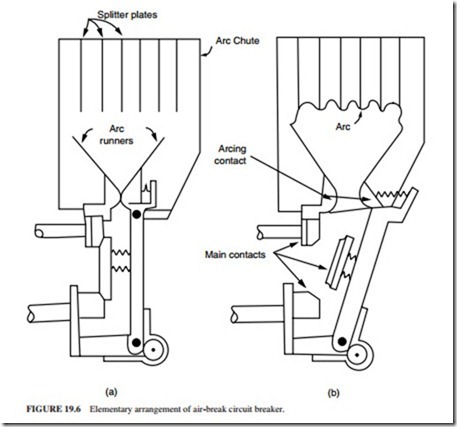OIL CIRCUIT BREAKERS
In oil circuit breakers, the arc energy is used to crack the oil molecules to generate hydrogen gas. The hydrogen is used to sweep, cool, and compress the arc plasma. This deionizes the arc plasma in a self-extinguishing process.
Even if the breaker contacts are immersed in oil, arcing still occur during contact sepa- ration. The heat from the arc evaporates the surrounding oil and dissociates it into carbon and a substantial volume of gaseous hydrogen at high pressure. The heat conductivity of hydrogen is high, resulting in cooling of the arc and the contacts. This increases the ignition voltage and extinguishes the arc.
The cooling caused by the hydrogen (due to its high conductivity) is very effective. It increases the voltage required for reignition significantly (5 to 10 times higher than the reignition voltage required for air).
Hydrogen is produced spontaneously in arcs under oil.
Interruption of heavy short-circuit currents generates extremely high pressures which should be released safely or controlled properly. These high pressures are used to extin- guish the arc which generated them.
Advantages of Oil
As an arc extinguishing medium, oil has the following advantages:
1. Oil produces hydrogen during arcing. The hydrogen helps extinguish the arc.
2. The oil provides insulation for the live exposed contacts from the earthed portions of the container.
3. Oil provides insulation between the contacts after the arc has been extinguished.
Disadvantages of Oil Circuit Breakers
Oil has the following disadvantages when used as an arc extinguishing medium:
1. Oil is inflammable and may cause fire hazards. When a defective circuit breaker fails under pressure, it may cause an explosion.
2. The hydrogen generated during arcing, when combined with air, may form an explo- sive mixture.
3. During arcing, oil decomposes and becomes polluted by carbon particles which reduces its dielectric strength. Hence, it requires periodic maintenance and replacement.
Plain Break Oil Circuit Breakers
In this type of circuit breaker the arc is confined only within the oil tank. Deionization of the arc is due to turbulence and increase of pressure (Fig. 19.7).
To ensure successful interruption, a long arc length is needed so that turbulence in the oil (caused by the pressures generated by the arc) helps in quenching the arc.
The tank should be weathertight to prevent moisture ingress (moisture will reduce the dielectric strength of the oil significantly).
Caution
1. If there is an air cushion on top of the oil, the hydrogen gas generated may mix with the air to form an explosive mixture. The air cushion should be kept to a minimum.
2. If the speed of contact movement is slow during short-circuit interruption, welding of the contacts may occur, resulting in a very dangerous situation and possible explosion.
The main features that affect the perfor- mance of a plain break oil circuit breaker are
1. Length of the break
2. Speed of contact movement
3. Head of oil above the contacts (to ensure adequate oil flow due to high pressure) during arcing
4. Clearance to earthed metal adjacent to the contacts
This type of circuit breaker is considered satis- factory up to 11 kV and 250 MVA.
Arc Control Circuit Breakers
Most oil control circuit breakers have an arc control mechanism. In these breakers, the gas produced during arcing is confined to small volumes by the use of an insulating, rigid arc chamber surrounding the contacts. Therefore, higher pressures can be generated during arcing to force the oil and gas through and around the
arc to extinguish it. These small high-pressure-resistant chambers are called arc control pots or explosion pots. These explosion pots have improved the efficiency of arc interruption and decreased significantly the risks of fire hazards. This improvement has resulted in signifi- cant reduction in arc duration time.
Related posts:
Incoming search terms:
- oil circuit breaker advantages disadvantages
- circuit breakers test equipment mail
- Advantages and disadvantages of oil circuit breaker
- Circuit Breakers mail
- self generated pressure oil circuit breaker
- advantages and disadvantages of oil explosion
- oil circuit breaker advantages
- Oil Breaker Diagram
- oil circuit breaker
- oil circuit breaker advantages and disadvantages
- advantage and disadvantage of oil circuit breaker
- plain break
- plain break oil circuit breaker
- why do plain break oil cb have low circuit interruption
- Merits and demerits of oil ci
- explotion pot oil circuit breaker
- explosion pot in oil circuit breaker
- advantage of oil as arc quench
- advantages and disadvantages of minimum oil circuit breaker
- advantages and disadvantages of oil circuit breakers
- advantages and disadvantages of oil filled circuit breakers
- advantages of explosive circuit breaker
- advanyage of oil c
- disadvantages oil circuit breaker
- explosion pot arc controlled oil circuit breaker
- EXPLOSION pot in a circiut breaker
- why plain break oil circuit breaker has low speed of interruption

